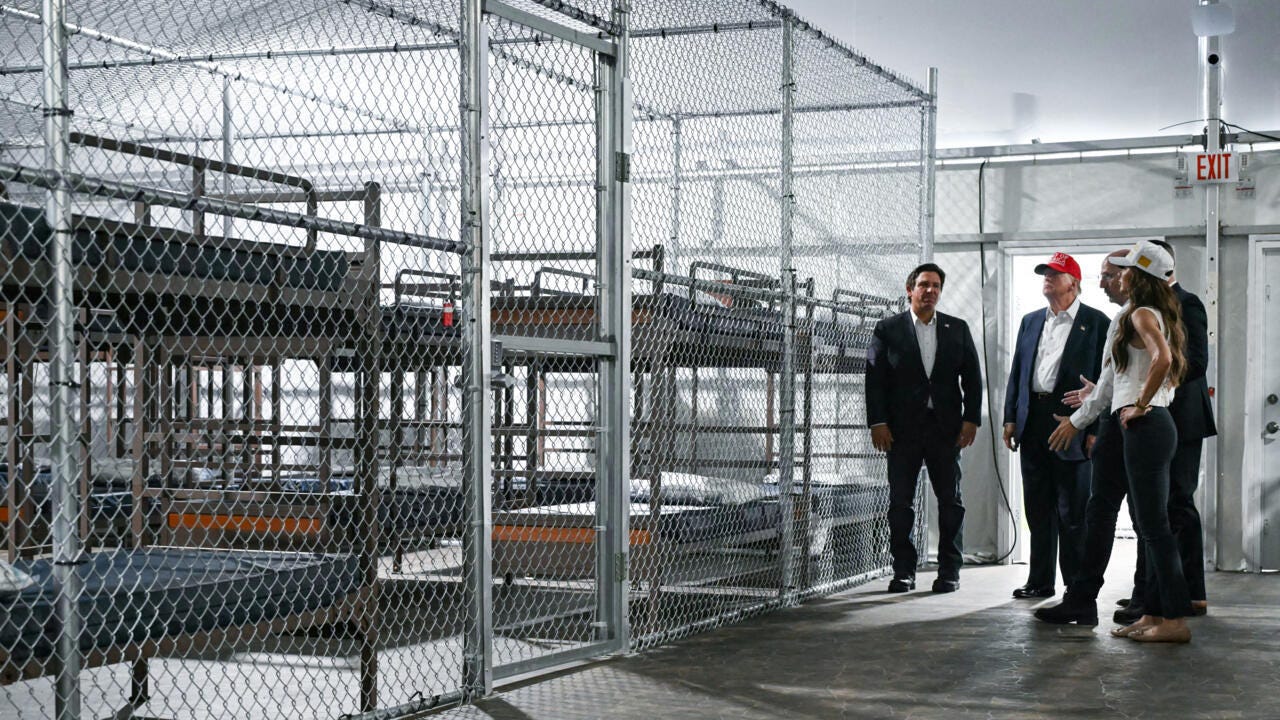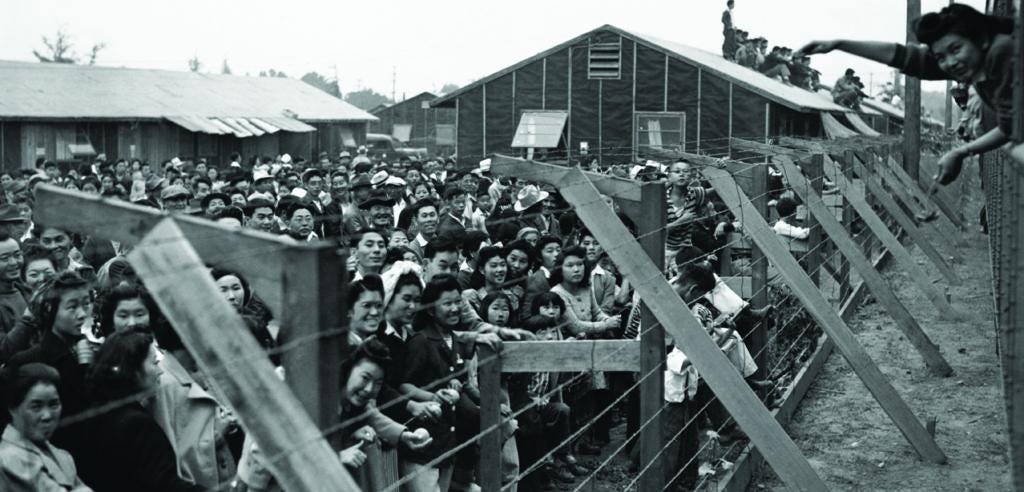America's Unlearned Lesson: From Manzanar to Alligator Alcatraz
The ghosts of America's past are not content to remain in the history books. They whisper, they echo, they scream, demanding our attention as patterns of injustice resurface with chilling familiarity.
This week, as we witnessed the construction and sickening celebrations of Florida's Alligator Alcatraz opening, it's impossible for anyone to ignore the haunting parallels to one of the darkest chapters in U.S. history: the internment of Japanese Americans during World War II. This isn't merely a comparison; it's a stark warning to how easily fear can erode fundamental liberties and how quickly a nation can forget its own history.
The Shadow of Executive Order 9066
Long before the bombs fell on Pearl Harbor, Japanese immigrants in America faced a relentless tide of discrimination. They were denied land ownership, segregated into enclaves, and legally deemed ineligible for U.S. citizenship, creating a precarious existence for the Issei (first-generation immigrants) and even their American-born children, the Nisei, who were citizens by birth. The Immigration Exclusion Act of 1924 slammed the door shut on further Japanese immigration, a clear sign of the deep-seated xenophobia that simmered beneath the surface in America.
Then came Pearl Harbor. President Franklin D. Roosevelt issued Executive Order 9066 on February 19, 1942. The order itself was neutral in its wording, authorising military commanders to exclude "any or all persons" from designated military areas. But Lieutenant General John L. DeWitt of the Western Defense Command wasted no time in applying it exclusively to Japanese Americans, initiating curfews and then, when "voluntary evacuation" failed, mandating forced removal with just 48 hours' notice. Congress swiftly backed this executive overreach with Public Law 503, making any violation a misdemeanour punishable by prison and hefty fines.
Within six months, approximately 122,000 men, women, and children were forcibly uprooted from their homes. Nearly 70,000 of them were American citizens. They were not charged with treason. They were not given hearings. They had no means to appeal their incarceration. The Department of Justice had initially raised constitutional objections, but the military proceeded anyway, bypassing critical legal scrutiny. This was not a subtle legal manoeuvre; it was a deliberate act of racial discrimination masked by claims of national security.
The Supreme Court in 1944, upheld the use of these camps, a ruling widely condemned as one of the Court's most controversial and only formally overturned in 2018. The judiciary, the supposed defenders of civil liberties, failed in its duty during the hysteria and anger that followed Pearl Harbor.
Internally, President Roosevelt and his officials, called them for what they truly were - concentration camps.
Life Behind Barbed Wire: Dehumanising Internees
The conditions within these internment/concentration camps were, by any humane standard, appalling. Families of four or five were crammed into tar-papered, army-style barracks. There was no privacy; communal latrines and showers lacked partitions, stripping internees of their basic dignity. There were no cooking facilities in the barracks, forcing people to queue three times a day, come rain or shine, for meagre rations in communal mess halls. Food was lacking in proper nutrients, leading to malnourishment, and outbreaks of food poisoning were common.
The health facilities were critically inadequate, a failure that directly contributed to widespread illness and preventable deaths. Overcrowding facilitated the rapid spread of diseases like typhoid, dysentery, smallpox, whooping cough, influenza, diphtheria, and tuberculosis. Tuberculosis alone accounted for over 10% of recorded deaths. Approximately 15% of deaths were attributed to starvation or dehydration. The remote, high-desert locations meant constant dust storms, leading to long-term respiratory issues like asthma and allergies. In Arkansas camps, malaria was an additional threat. In total, 1,862 deaths were recorded in the camps. Seven confirmed homicides were committed by sentries.
The psychological scars ran even deeper. Internees faced a significantly higher risk of post-traumatic stress symptoms, with one study finding 36.7% exhibited PTSD within six months of release. Suicide rates for Japanese Americans doubled, a four-fold increase from pre-incarceration rates. This trauma was often passed down through generations, where Nisei parents, perhaps out of shame or a desire to protect their children, rarely discussed their experiences. This silence inadvertently led to feelings of low self-esteem, pressure to assimilate, and an accelerated loss of Japanese culture and language among the third generation.
Economically, it meant rapid, disposal of assets. Total property losses are estimated in the billions, with net income losses far greater. Camp residents lost approximately $400 million in property during their incarceration. This was a systematic disposal of wealth, designed to make returning to their former lives incredibly difficult. Established ethnic neighbourhoods were gutted and communities broken up across the country after the war.
It took decades for the U.S. government to formally acknowledge this injustice. The Civil Liberties Act of 1988 finally issued a national apology and provided a meagre $20,000 cash payment to each surviving internee. A derisory amount, but one that came with a crucial admission of guilt.
American Immigration Detention Today
Fast forward to today, and the echoes are deafening. The U.S. operates a vast network of immigration detention facilities, holding individuals during their immigration proceedings. These facilities are run by various agencies, including ICE, ORR, and CBP. Legally, immigration detention is classified as civil detention, meaning individuals should not be held in correctional conditions. The Fifth and Fourteenth Amendments supposedly guarantee basic human needs – food, clothing, shelter, medical care, and reasonable safety – to all persons within U.S. borders, including immigrant detainees. ICE even has its own National Detention Standards, updated as recently as 2019, which it claims all facilities must follow.
Yet, the reality on the ground, as reported by the likes of Amnesty International and the ACLU, paint a different picture. Amnesty's 2025 report on the El Paso Service Processing Centre documented "disturbing patterns of abuse and systemic violations". Allegations include arbitrary detention, a lack of access to legal resources and due process, and inhumane and unsanitary conditions: overcrowding, dysfunctional toilets, and poor-quality, expired food. Reports also detail inadequate medical care, physical abuse by guards, and the use of solitary confinement. Detainees describe family separation, a lack of communication with loved ones, and significant mental distress. The ACLU, through FOIA litigation, raised alarms about ICE capacity and plans for expanded detention facilities nationwide.
The Department of Homeland Security (DHS) and ICE, issued strong rebuttals, asserting these claims were "categorically false" and that detainees receive proper meals, medical treatment, and communication opportunities. They even claim ICE facilities uphold "higher detention quality standards than most U.S. detention spaces actual U.S. citizens". DHS maintains that enforcement operations are "highly targeted" at individuals with criminal convictions, denying any racial profiling. This is the familiar defence of denial, a government attempting to control the narrative while external scrutiny reveals the true horrors.
Unlike in criminal court, individuals facing deportation are not entitled to a court-appointed attorney if they cannot afford one. This means an estimated 70% of individuals in immigration detention without legal representation. Additionally, the expansion of fast track removal policies allows DHS to detain and deport individuals without a hearing before an immigration judge, effectively bypassing traditional courts. Detainees frequently report a lack of access to attorneys, prolonged detention without clear explanation, and limited access to legal resources. The use of the 1798 Alien Enemies Act, against specific nationalities like Venezuelans, raises further alarms about due process. There was even talk of the Trump administration suspending access to habeas corpus, an extraordinary measure that would further prevent judicial review.
And then there is Florida's Alligator Alcatraz. This facility, located in the Florida Everglades, has been christened with a name that speaks volumes. The name, used by both local officials and critics, stems from its remote, treacherous environment and the presence of dangerous wildlife, including alligators. Its purpose: to house, process, and deport individuals deemed to be in the country illegally, with a capacity for thousands. The site was reportedly built in just eight days to accommodate detainees.
During a tour, President Trump characterised the facility as "so professional and so well done," suggesting it could be a model for other detention sites. He even made a controversial joke about teaching escapees "how to run away from an alligator". The facility boasts rows of bunk beds behind chain fences, at least 200 security cameras, 28,000 feet of barbed wire, and over 400 security personnel. This emphasis on security, control, and the dangers of the surrounding environment, coupled with the rapid, makeshift construction, screams of a system prioritising deterrence and punishment over humane treatment. It's a chilling echo of the Japanese American concentration camps during the Second World War.
American History's Unlearned Lessons
The parallels between these two periods, separated by decades, are not accidental; they are systemic. Both demonstrate how easily it is for a nation, gripped by fear or in supposed crisis, can resort to the arbitrary detention of specific populations, bypassing fundamental human and civil rights.
Executive Order 9066, though ethnically neutral on paper, was applied with discriminatory intent to Japanese Americans, including American citizens, without charges or appeal. Today, while immigration detention is legally civil, the expansion of expedited removal and the use of the Alien Enemies Act allow for detention and deportation without meaningful judicial review, effectively creating a system of random confinement. The legal structures are different, but the practical outcome – individuals stripped of liberty without due process – is very similar.
The Japanese American camps were characterised by basic, unsanitary, and overcrowded conditions, leading to widespread disease, malnourishment, and preventable deaths. Today, despite official written standards, human rights organisations report continued violations in immigration detention facilities, including overcrowding, unsanitary conditions, inadequate medical care, and poor food quality. The Alligator Alcatraz facility, with its remote location and extensive barbed wire, reinforces the notion that control will trump humane conditions. The dehumanising aspects of confinement, whether through lack of privacy in communal facilities or the threat of dangerous wildlife, remain a constant.
Japanese Americans were systematically denied charges, hearings, and appeals. In present day immigration detention, while due process supposedly applies to all persons, the practical absence of court-appointed attorneys and the increase of fast track removal processes render these rights largely inaccessible for many. The right exists on paper, but the means to exercise it are not, creating a two-tiered justice system.
The WW2 internment primarily targeted individuals of Japanese ancestry, driven by racial prejudice and wartime hysteria. Today, immigration detention targets non-citizens, but the reported use of the Alien Enemies Act against specific nationalities raises concerns about profiling based on national origin, echoing the targeting of undesirable groups. In both eras, a vulnerable population is identified and subjected to mass detention outside typical judicial normality, fuelled by xenophobic narratives.
The legacy of the Japanese American concentration camps is not just a historical footnote; it is an enduring cautionary tale. It should reminds us of the dangers of unchecked governmental authority and the fragile nature of human and civil rights during periods of national anxiety and hysteria. The devastating long-term impacts on individuals, families, and communities serve as a stark reminder of the human cost of such policies.
Before too long, American citizens will be interned in such camps, opponents of Trump and MAGA, intellectuals and any other undesirables that the current regime sees fit to kidnap off the streets across America. Reminiscent of Nazi Germany in the 1930s and 40s.
When we hear Republican politicians and the likes of Trump boasting about facilities designed for rapid processing and maximum security, or joke about alligators, we must recognize the chilling echoes of a past that America swore they would never repeat. The struggle for justice and equality is not confined to history books; it is an ongoing battle that demands constant vigilance, ensuring that the lessons of the past are truly learned, not merely acknowledged, forgotten and repeated once again.






